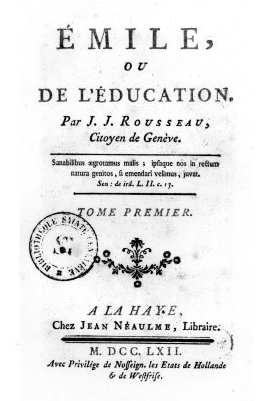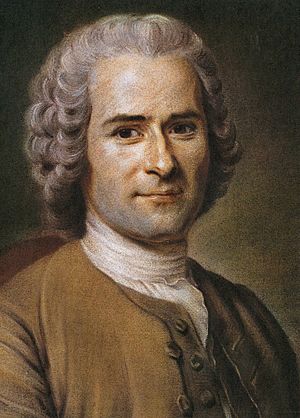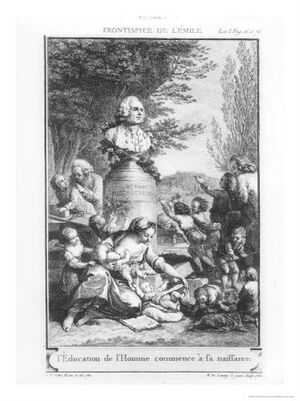Emile, or On Education facts for kids

Title page of Rousseau's Emile
|
|
| Author | Jean-Jacques Rousseau |
|---|---|
| Country | Republic of Geneva and France |
| Language | French |
| Subject | Pedagogy |
|
Publication date
|
1762 |
|
Published in English
|
1763 |
Emile, or On Education (French: Émile, ou De l’éducation) is a famous book about education and human nature. It was written by Jean-Jacques Rousseau, a well-known thinker. He believed it was his most important work.
The book talks about how to raise a child to be a good person. It suggests that children should learn from nature and their experiences, not just from books. Because of some ideas in the book, especially a part called "Profession of Faith of the Savoyard Vicar," Emile was banned in Paris and Geneva in 1762. It was even publicly burned! The Catholic Church also banned it. Later, during the French Revolution, Emile helped inspire new ideas for a national education system.
Contents
Main Ideas on Education
This book explores big questions about how people fit into society. Rousseau wondered how a person could stay naturally good while living in a world that might try to change them. He famously wrote: "Everything is good as it leaves the hands of the Author of things; everything degenerates in the hands of man." This means he believed people are born good, but society can make them less so.
Rousseau tried to describe a way of educating a "natural person" so they could live well in society. He used the story of a boy named Emile and his tutor (teacher) to show his ideas. While it's not a detailed guide for parents, Emile offers important advice on raising children. Many people see it as one of the first complete books on the philosophy of education in Western culture. It's also considered one of the first Bildungsroman novels, which are stories about a character's moral and psychological growth.
How the Book is Organized
Emile is divided into five main parts, called "books."
- The first three books focus on Emile as a child.
- The fourth book looks at Emile as a teenager.
- The fifth book talks about the education of Sophie, a girl who will become Emile's wife. It also covers Emile's adult life.
Book 1: Early Years

In Book 1, Rousseau shares his main ideas about education. He explains how to raise a child according to his philosophy. He starts by discussing how babies and young children develop physically and emotionally.
Rousseau wanted to find a way for a "natural person" to live in society. He believed that society often forces people to change their natural instincts. But he also thought this change wasn't always bad. Emile tries to show how a natural person can live happily within society.
Many of Rousseau's suggestions in this book were similar to ideas from other education reformers. For example, he agreed with John Locke that children should be made strong. He also stressed the dangers of swaddling (tightly wrapping babies) and the benefits of mothers feeding their own infants. Rousseau strongly believed that if mothers nursed their children, society would improve. His ideas, though not always new, helped change how people thought about swaddling and breastfeeding.
Book 2: Learning from the World
The second book focuses on how children first interact with the world. Rousseau believed that at this age, children should learn less from books. Instead, they should learn by exploring and experiencing things. He emphasized developing their senses and their ability to figure things out from what they observe.
Rousseau gives an example of a boy who learns well this way. His father takes him flying kites and asks him to guess the kite's position just by looking at its shadow. The boy had never been taught this specific task. But by using what he knew about the world, he could succeed. This approach is similar to the Montessori method used today.
Book 3: Choosing a Skill
The third book discusses choosing a trade or skill. Rousseau thought it was important for a child to learn a practical skill. This skill should fit their age, gender, and interests. It should also be taught by good role models.
Book 4: Teenage Years and Feelings
Once Emile is strong and observant, he's ready for the next part of his education: learning about feelings. Rousseau believed that a person becomes complete by perfecting their reason with feelings. Emile is a teenager at this point. Rousseau thought that only now could Emile understand complex human emotions, especially sympathy. He argued that children can't understand others' feelings. But once they become teenagers, they can learn to connect with society.
During Emile's teenage years, his teacher also introduces him to religion. Rousseau believed that children under 15 or 16 can't understand big ideas like the soul. So, introducing religion too early could be harmful. He wrote that it's better not to know about God than to misunderstand Him. Children would just repeat what they're told without truly believing it.
Book 4 also contains the famous "Profession of Faith of the Savoyard Vicar." This section was a main reason why Emile was banned. Rousseau explained that he wrote this part not as a strict rule for religious beliefs. Instead, it was an example of how a teacher could discuss religion with a student. Through the priest, Rousseau suggests believing in "natural religion," which is a basic belief in God based on reason and nature.
Book 5: Sophie and Adult Life
In Book 5, Rousseau describes the education of Sophie, who is meant to be Emile's wife.
Rousseau explains what he sees as the natural differences between boys and girls. He believed that men and women are equal in many ways. But they are different in how they contribute to a family. He thought a perfect woman and a perfect man should not be exactly alike in their minds or looks.
For Rousseau, women should be "passive and weak" and "made specially to please man." However, he also said that men should please women in return. He saw men's strength as a natural law.
Rousseau's ideas about girls' education were common at the time. In the 1700s, girls were usually taught home skills like sewing, cooking, and housekeeping. This was because they were expected to stay in their homes, which Rousseau supported.
Rousseau's brief ideas on female education caused a huge reaction. Mary Wollstonecraft, a famous writer, strongly disagreed with him. In her book A Vindication of the Rights of Woman (1792), she spent a lot of time criticizing Rousseau's arguments. She quoted him saying, "Educate women like men... and the less power will they have over us." Wollstonecraft responded that she didn't want women to have power over men, but "over themselves."
Another French writer, Louise d'Épinay, also disagreed with Rousseau. In her book Conversations d'Emilie, she argued that girls' education affects their role in society, not just natural differences.
Rousseau also included a short version of his book The Social Contract in Book 5. The Social Contract was published in the same year as Emile and was also banned. It discussed ideas about how people should govern themselves.
Émile et Sophie
After Rousseau's death, an unfinished sequel to Emile was published. It was called Émile et Sophie (English: Emilius and Sophia). This book continued the story of Emile and Sophie. Experts say it shows Rousseau's amazing talent for combining literature and philosophy.
What People Thought of Emile
Rousseau's rival, Voltaire, didn't like Emile overall. But he did admire the "Profession of Faith of the Savoyard Vicar" section, even though it was the reason the book was banned. Voltaire called that part "fifty good pages."
The German writer Johann Wolfgang von Goethe wrote in 1787 that Emile had a big impact on educated people everywhere.
See also
- Original Stories from Real Life, a book by Mary Wollstonecraft that responded to Emile
- Robinson Crusoe, a novel that influenced Rousseau's ideas



